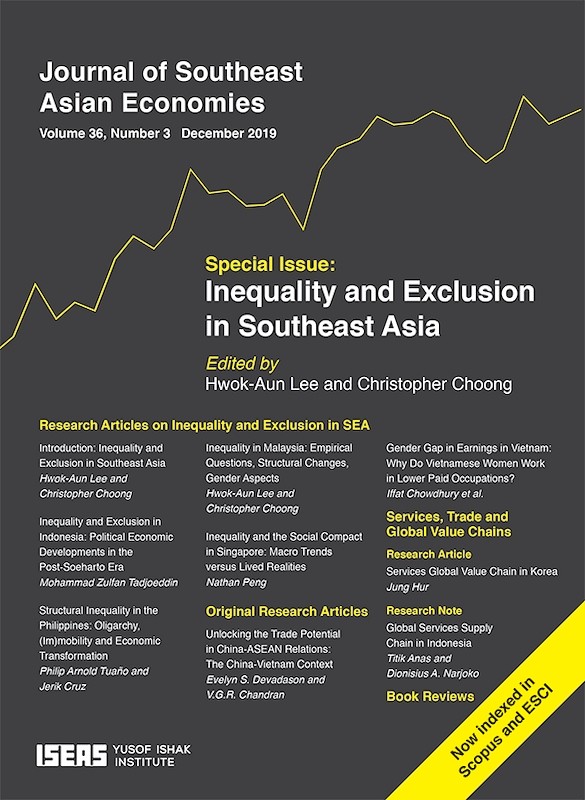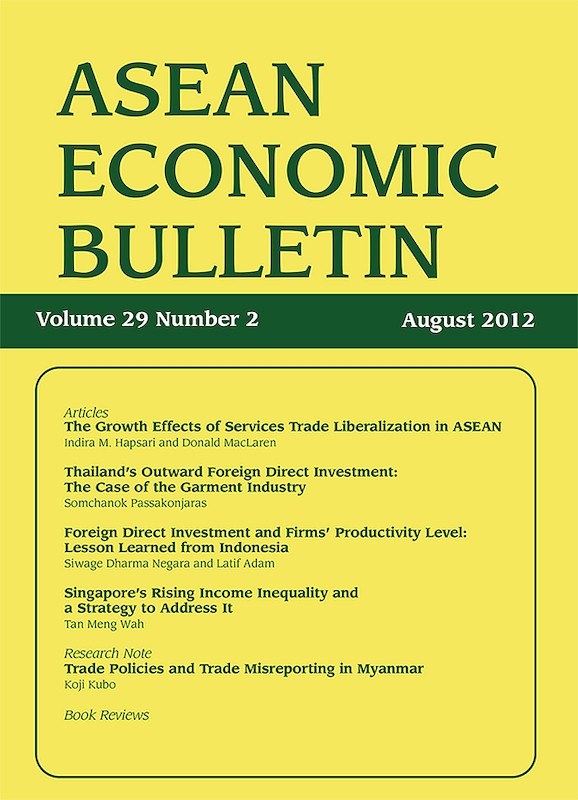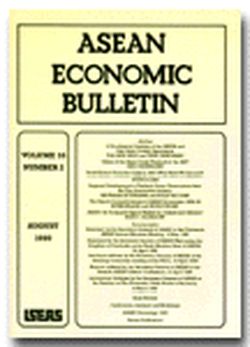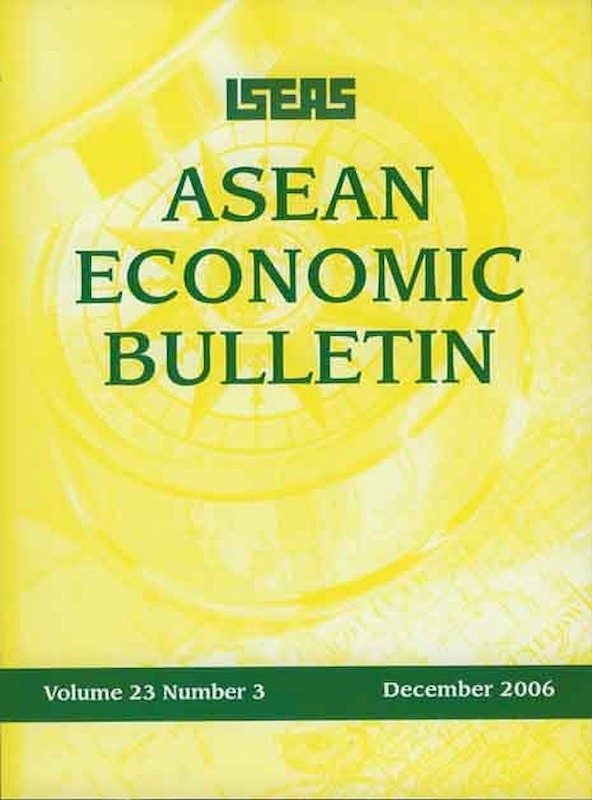ASEAN Economic Bulletin Vol. 6/1 (Jul 1989)
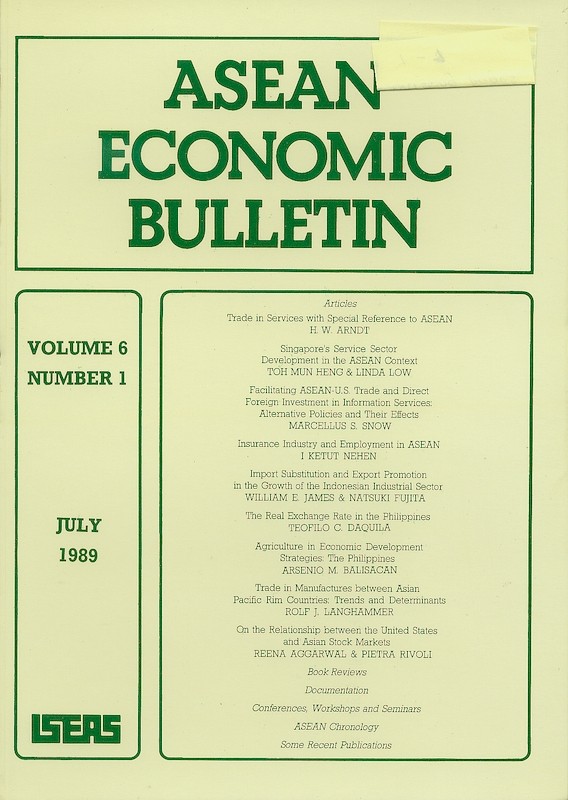
Date of publication:
July 1989
Number of pages:
141
Code:
AE6/1
Contents
-
Preliminary pages
- ARTICLES
-
Trade in Services with Special Reference to ASEAN, by Heinz W Arndt, author see abstractThe primary purpose of this article is to sort out the confusion which has bedeviled the definition of service trade in recent discussion, and especially the failure to distinguish non-factor from factor services. The article proposes a realistic typology of trade in non-factor services. It concludes with a discussion of statistics of service trade of ASEAN countries, pointing out that data inadequacy at this stage preludes any useful assessment of the size, structure or determinants of this important component of ASEAN trade.
-
Singapore's Service Sector Development in the ASEAN Context, by Toh Mun Heng, Linda Low, authors see abstractThis paper has two main aims. One is to review the growth of the service sector in Singapore in terms of its "old" and "new" services. The old services are primarily in entrepot activities while the new ones have evolved as much in response to economic restructuring and diversification as to the challenges posed by new demand and technologies. Even old entrepot services are upgraded into new ones like counter trade as more dynamic ones in telecommunications, information technology, communications and travel evolve. The complementarity and linkages between the old and new are thus analyzed. A second related objective is to assess the implications of these trends in service sector development on Singapore's traditional hinterland in the Association of Southeast Asian Nations (ASEAN). With their own service sectors in particular, and overall economic development in general being promoted, it is germane to know whether Singapore's service sector will draw more forces of competition or interdependency in the ASEAN context. While the prognosis on balance is favourable, the paper has also noted some domestic and international issues and constraints for the service sector. The main domestic issue is on the weak link in the people dimension in terms of manpower support though there is tremendous government support in this and all related areas of service promotion. In the international arena, the issues are more perplexing as trade liberalization in services and deregulation remains unresolved.
-
Facilitating ASEAN-U.S. Trade and Direct Foreign Investment in Information Services: Alternative Policies and Their Effects, by Marcellus S Snow, author see abstractPolicy issues relating to trade and direct foreign investment in information services for promoting ASEAN-U.S. economic development are examined. The importance of information is treated us a service and resource in the world economy. Traditional regulation and protection of developed-country information services is summarized with regard to telecommunications, banking, and intellectual property, stressing the telematic interaction of banking and telecommunications in development. Recent trends in information services liberalization and their effects in the United States, Western Europe, and Japan are examined. Policy recommendations for similar liberalization affecting ASEAN-U.S. trade and investment, including a conceptual and policy discussion of the similarities and differences between trade and direct foreign investment in services, are set forth. The final section argues that such policies will result in export-led growth, allocative efficiency, technology transfer and competition, as well as favourable social, cultural, and political effects.
-
Insurance Industry and Employment in ASEAN, by I Ketut Nehen, author see abstractA survey of the insurance industry in the ASEAN countries indicates that the rate of growth of premium income is higher than the rate of growth of its gross national product for the period under study. This was taken to indicate that the insurance industry in the region has vast potential for further growth. However, the governments of the ASEAN countries have adopted a policy to suspend the licensing of new establishments, arguing that there were already too many small domestic insurance companies which led to keen competition. This reason is not acceptable and such a policy cannot appropriately achieve the stated objectives. There are some indications that such a policy was also adopted in other sectors of the economy, deterring seriously employment creation, an oft-stated-objective of national development in many developing countries, including those of ASEAN.
-
Import Substitution and Export Promotion in the Growth of the Indonesian Industrial Sector, by William E James, Natsuki Fujita, authors see abstractIndonesia lagged behind most Asian developing economies in growth and industrialization during the 1960s. In the 1970s, however, Indonesia experienced very high real growth and this was reflected in rapid expansion of the industrial sector. There was a subtle change in policy emphasis during the mid-1970s away from the import substitution strategy in favour of a more export-oriented approach. This study seeks to evaluate how successful this was in making use of input-output analysis, using data from 1971, 1975, and 1980. The sources of output expansion are decomposed into four categories: domestic final demand, export demand, import substitution, and technological change. The findings indicate that the measures designed to stimulate export growth were moderately successful.
-
The Real Exchange Rate in the Philippines, by Teofilo C Daquila, author see abstractThe paper analyses the real exchange rate (RER) in the Philippines during the 1967-84 period. It uses the tradable/non-tradable framework, It concludes that: (1) the tradable/non-tradable framework is relevant in analyzing the real exchange rate in the Philippines; (2) a significant relationship between the current account balance and the RER exists; and (3) a significant relationship between sectoral output and the RER exists.
-
Agriculture in Economic Development Strategies: The Philippines, by Arsenio Molina Balisacan, author see abstractThis paper discusses the general character of post-war Philippine economic development and the elements and implications of an agriculture- and employment-led development strategy (AEDS) that is deemed superior to addressing the twin problems of abject poverty and high unemployment and underemployment in the Philippines. AEDS, proposed as an alternative development strategy, calls for the elimination of the biases of public policy against agriculture, thereby giving agriculture a central place in the development process. The key is to enhance rural income growth and industrialization through the employment and income multiplier effects of productivity increases in agriculture. While agricultural growth is not the ultimate objective of development policy, it is a critical step which must not be missed, for the mechanism of agricultural growth and the sequence of employment and income multiplier effects it sets in motion throughout the economy represent the key to a rapid, broad-based, and self-sustaining economic development.
-
Trade in Manufactures between Asian Pacific Rim Countries: Trends and Determinants, by Rolf J Langhammer, author see abstractThe paper analyses changes in the regional composition of trade in manufactures between the Asian countries of the Pacific Rim (PACRIM) in the 1965-85 period and applies a gravity model approach in order to sift out determinants of bilateral trade in the Asian Pacific Rim area. Finally, changing degrees of intra-industry specialization in trade between five regional groups in the area are measured and compared. The results suggest Japanese-Chinese trade to be the driving force of intra-PACRIM trade in the early eighties. In the total sample of bilateral trade flows relatively physical capital-intensive goods exported from countries with a large manufacturing capacity and relatively small domestic markets emerge as dominating segments. Intra-industry specialization has increased during the period albeit starting from very different levels in individual countries and groups.
-
The Relationship between the U.S. and Four Asian Stock Markets, by Reena Aggarwal, Pietra Rivoli, authors see abstractConventional wisdom among academic researchers suggests that there is a high degree of independence between equity returns in the United States and those in other countries. However, practitioners often suggest that other markets tend to be strongly influenced by the behaviour of the U.S. market. This paper examines the day-to-day linkages between equity returns in the United States and those in four Asian equity markets, showing a significant tendency for these Asian markets to follow the U.S. markets on a day-to-day basis. Secondly, the paper examines whether the well-known negative Monday effect in the U.S. concurs with a negative Tuesday effect in the Asian markets and finds evidence of this tendency. Finally, evidence is presented to show that the Asian markets studied exhibit a weekend effect similar to the effect consistently observed in the United States. The paper concludes that there are significant tendencies towards day-to-day linkages between stock price behaviour in the United States and stock price behaviour in Hong Kong, Singapore, Malaysia, and the Philippines, and that the day of the week effect observed in the United States also occurs in these Asian markets.
-
BOOK REVIEW: Financing for Development: With Special Reference to ASEAN, edited by Faridah Shahadan and Nor Aini Haji Idris, by Heinz W Arndt, author
-
BOOK REVIEW: Foreign Investment and Industrialization in Indonesia, by Hal Hill, by Jurgen Riedel, author
-
BOOK REVIEW: Economic Impact of Generalised Tariff Preferences, by Rolf J Langhammer and Andre Sapir, by Chng Meng Kng , author
-
BOOK REVIEW: Trade Routes to Sustained Economic Growth: Report for the United Nations by a Study Group of the Trade Policy Research Centre, by Amnuay Viravan and Others, by Chng Meng Kng , author
-
DOCUMENTATION: Address by Prime Minister Noboru Takeshita on "Japan and ASEAN: Thinking Together and Advancing Together", Jakarta, 5 May 1989.
-
Conferences, Workshops and Seminars
-
ASEAN Chronology 1989
-
Some Recent Publications

